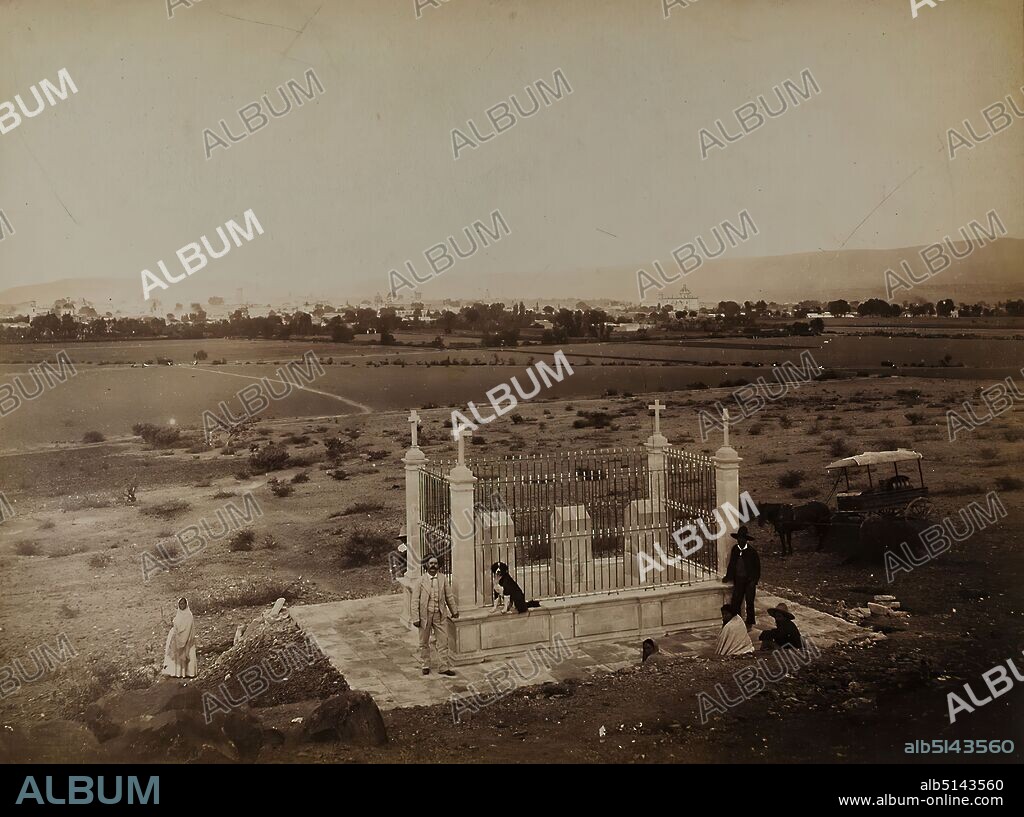alb5143560
William Henry Jackson, Querétaro, Mexico. Monument to Maximilian von Habsburg, albumin paper, black and white positive process, image size: height: 25 cm; width: 33.6 cm, inscription: verso: in lead: v. Hesse - Wartegg, Geographical Society, in Hamburg, library, travel photography, monument, landscape with plants, city, city view (veduta), group portrait, vehicles covered with animals (carriage etc.), man, woman, dog, horse, standing figure, sitting figure, headgear, hist. Building, location, street, Mexico, With the aim of establishing a monarchy in Mexico dependent on France, the Habsburg Ferdinand Maximilian of Austria (1832-1867) was enthroned as Emperor of Mexico in 1864 at the instigation of Napoleon III. After the withdrawal of the French in 1866, Maximilian could no longer hold on to power. In May 1867, he was captured by the troops of the legitimate government around Benito Juárez in Querétaro and, following a court-martial decision, was shot on June 19, 1867, along with his generals Miguel Miramón and Tomás Mejía. In 1886, a first monument was erected at the place of execution, which the American photographic pioneer William Henry Jackson (1843-1942) captured in pictures during his excursions to Mexico. It consisted of three enclosed stone pillars with the names of the executed. Today, a chapel consecrated in April 1901 commemorates Maximilian at this site.

|
Ajouter à une autre Lightbox |
|
Ajouter à une autre Lightbox |



Avez-vous déjà un compte? S'identifier
Vous n'avez pas de compte ? S'inscrire
Acheter cette image.
Sélectionnez l'usage:

Légende:
Voir la traduction automatique
William Henry Jackson, Querétaro, Mexico. Monument to Maximilian von Habsburg, albumin paper, black and white positive process, image size: height: 25 cm; width: 33.6 cm, inscription: verso: in lead: v. Hesse - Wartegg, Geographical Society, in Hamburg, library, travel photography, monument, landscape with plants, city, city view (veduta), group portrait, vehicles covered with animals (carriage etc.), man, woman, dog, horse, standing figure, sitting figure, headgear, hist. Building, location, street, Mexico, With the aim of establishing a monarchy in Mexico dependent on France, the Habsburg Ferdinand Maximilian of Austria (1832-1867) was enthroned as Emperor of Mexico in 1864 at the instigation of Napoleon III. After the withdrawal of the French in 1866, Maximilian could no longer hold on to power. In May 1867, he was captured by the troops of the legitimate government around Benito Juárez in Querétaro and, following a court-martial decision, was shot on June 19, 1867, along with his generals Miguel Miramón and Tomás Mejía. In 1886, a first monument was erected at the place of execution, which the American photographic pioneer William Henry Jackson (1843-1942) captured in pictures during his excursions to Mexico. It consisted of three enclosed stone pillars with the names of the executed. Today, a chapel consecrated in April 1901 commemorates Maximilian at this site.
Personnalités:
Crédit:
Album / quintlox
Autorisations:
Modèle: Non - Propriété: Non
Questions sur les droits?
Questions sur les droits?
Taille de l'image:
4320 x 3222 px | 39.8 MB
Taille d'impression:
36.6 x 27.3 cm | 14.4 x 10.7 in (300 dpi)
Mots clés:
ANIMAL • ANIMAL: CHEVAL • ANIMAUX • ARCHITECTURE: BIBLIOTHEQUE • BÂTIMENT • BATIMENTS • BIBLIOTHEQUE • BUILDING • CADRE • CANIN • CHEVAL • CHEVAUX • CHIEN • CITE • CONTEMPORAIN • ECRITURE BIBLIOTHEQUE • ÉDIFICE • EMPEREUR • EMPEREURS • EXCURSION • EXECUTION CAPITALE • EXECUTION • FEMELLE • FEMM • FEMME • FRANÁAIS • FRANÁAISE • FRANCE • FRANÇAIS • HOMME • IMAGES • INSCRIPTION • INTERIEUR: TABLEAUX • MEXICO • MEXIQUE • MONARCHIE • MORT EXECUTION • NOIR • PAYSAGE • PEINDRE • PEINTURE, SCENES D'INTERIE • PHOTO DE GROUPE • PHOTOGRAPHIE DE VOYAGE • PLANTE • PORTRAIT DE GROUPE • RUE • SOUVERAIN EMPEREUR • TABLEAU: SCENES D'INTERIEU • TABLEAUX • TITRE, EMPEREUR • TOMÁS MEJÍA • VEDUTE • VEGETAUX • VILE • VILLE • VUE VILLES • WILLIAM HENRY JACKSON
 Pinterest
Pinterest Twitter
Twitter Facebook
Facebook Copier le lien
Copier le lien Email
Email
